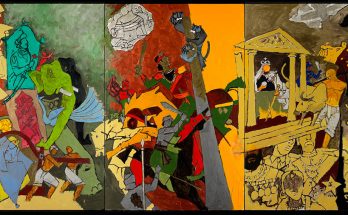 Hyelim Kim may be a new face to some, but within Korean traditional music circles, she is well-respected and known for performing the taegum (Korean flute) in many countries around the world. She recently appeared in Denmark at several concerts, and was onstage at the Royal Opera House in London alongside Derek Jacobi and a pair of camels! Ms Kim is now preparing to perform with a host of musicians from Asia and Europe on June 6 in celebration of her new CD being released by Universal Music Korea. Tickets for the event at the Royal Asiatic Society in London may be purchased here. Hyelim Kim was kind enough to sit down with AGI for an exclusive interview.
Hyelim Kim may be a new face to some, but within Korean traditional music circles, she is well-respected and known for performing the taegum (Korean flute) in many countries around the world. She recently appeared in Denmark at several concerts, and was onstage at the Royal Opera House in London alongside Derek Jacobi and a pair of camels! Ms Kim is now preparing to perform with a host of musicians from Asia and Europe on June 6 in celebration of her new CD being released by Universal Music Korea. Tickets for the event at the Royal Asiatic Society in London may be purchased here. Hyelim Kim was kind enough to sit down with AGI for an exclusive interview.
AGI: Could you tell us a bit about your background and how you came to be interested in traditional Korean music?
Kim: Well, I was born in Korea, in a city called Daegu. I used to like all sorts of musical instruments, such as violin, piano, and the recorder of course. But later on, actually my father was very interested in traditional instruments like the vertical flute (tanso) and the transverse flute (taegum). And I was totally in love with those flutes. We actually harvested bamboo ourselves to make a flute out of it. It was really fun because you could see the whole process of how the bamboo becomes an instrument. That was one of the critical motivations that made me decide to be a traditional musician, and I was sent to a secondary school for Korean traditional music which is quite rare. I don’t think many other countries have that kind of school which is fully dedicated to traditional music.
Can you explain more about the taegum (Korean traditional flute) and what makes it unique?
It is made of bamboo, as I mentioned, but it is made from huge bamboo, not small bamboo. There are two main types of taegum – one is slightly longer than the other. That is for court music. I perform mainly that kind of taegum, which was used in front of the royal family and aristocratic people [in the past]. The other kind of taegum is for folk music, which can articulate more feelings through expressive techniques and tone colours. The other interesting thing about the taegum is that it has a kind of membrane which makes a buzzing sound if I blow on it hard, and this creates a unique timbre.
What are some of the main differences between Chinese, Japanese and Korean traditional music?
In terms of ritual music, there are a lot of similarites, because some parts of the court music have been imported from China or influenced by Japan and China, so we have much in common, but of course we also have very original court music of our own. But in terms of folk music, it has a lot more freedom which the performer can explore. In the case of Japanese folk music, they have a very strict school system in which you must follow the specific rules and techniques. But in Korea, it is focussed more on individuality and musical identity – so I think that’s one big difference. And in Chinese music, they prefer very high-pitched notes, and the tone colours are very refined, whereas in Korean music, we use a wide spectrum of tone colours, including harsh sounds, depending on the feeling we are trying to express.
You are studying now in SOAS (the School of Oriental and African Studies) at the University of London. What are you studying about exactly and why did you choose to study in the UK?
I’m a PhD student in ethnomusicology [the study of the music of different cultures]. Even in this field there are so many subfields, but what I’m working on is performance as research which seemed to be quite relevant to what I’m doing now. I’m a musician, but I’m also academically trained, so what I’m trying to do is build some bridges between the academic field and the performance field. The reason why I chose to study at SOAS in London is also related to my study subject. I’ve been trained as a Korean traditional musician for more than 10 years, so my knowledge about that music is enough to see it objectively. And now I want to put that music in a different context and make some connections between Korea and Western countries. I have always felt ashamed that my beloved Korean music hasn’t been much introduced outside of Korea. So I’m trying to find ways to make non-Korean people understand or feel the beauty of Korean music more effectively. Also the city itself [London] is full of cultural events, historical buildings and remains; the easy access to history makes me awakened to the rich culture in Europe.
Can you tell us about some of your recent and upcoming performances in the UK?
First of all, I was invited by the BBC last year to perform with two other musicians in a collaboration – one was a hip-hop artist based in London called Ghostpoet, and the other was a German pianist, Nils Frahm. Each of us are from totally different musical background, but in the studio we made a really interesting session and I believe the result was quite productive and people loved it! And my upcoming concert, Pochagi, will be another collaboration with other musicians based in London – one is Japanese [Hibiki Ichigawa], a shamisen player, another is Chinese [Dennis Lee], xiao (flute) player; and there is also Mark Troop, a British pianist, who is really interested in East Asian music. So all of these musicians will be getting together to create something totally transcultural.
And lastly, what can you say about your new CD [Nim: Hyelim Kim Taegum Collection]?
I got an offer from Universal Music Korea to put out a solo CD a while ago. It is titled ‘Nim’ which is a word of respect for an older person in Korea. To celebrate this CD being released in May, I’m going to hold a CD launch concert on the 6th of June at the Royal Asiatic Society in London [‘Pochagi’, mentioned before]. If you come to the concert, you can buy the CD there, or you can purchase it online at YesAsia.com. You can also hear a few clips from the CD at SoundCloud.com.
Interview by Tim Holm



